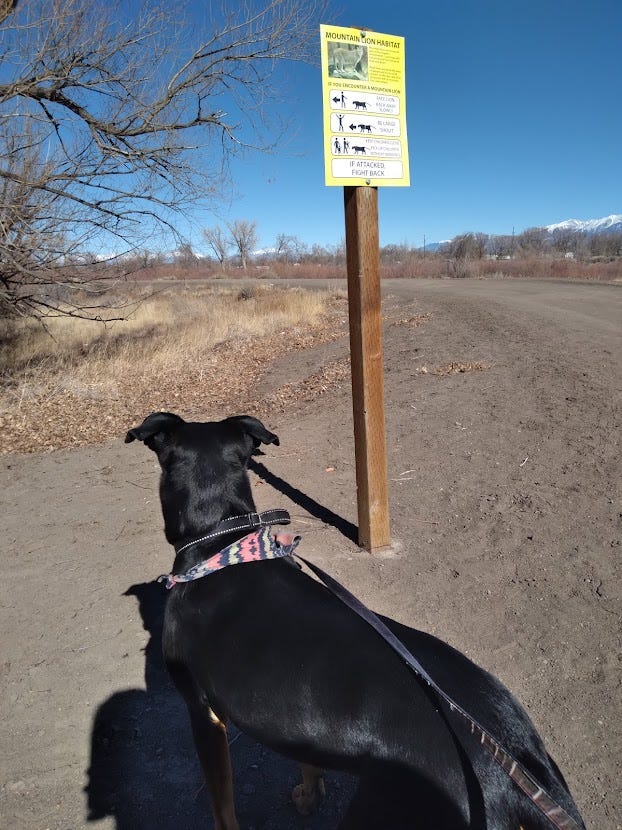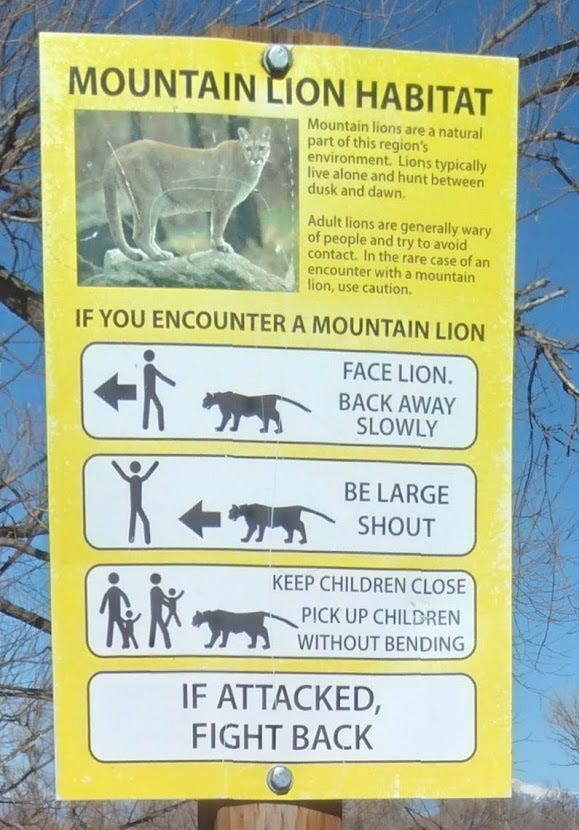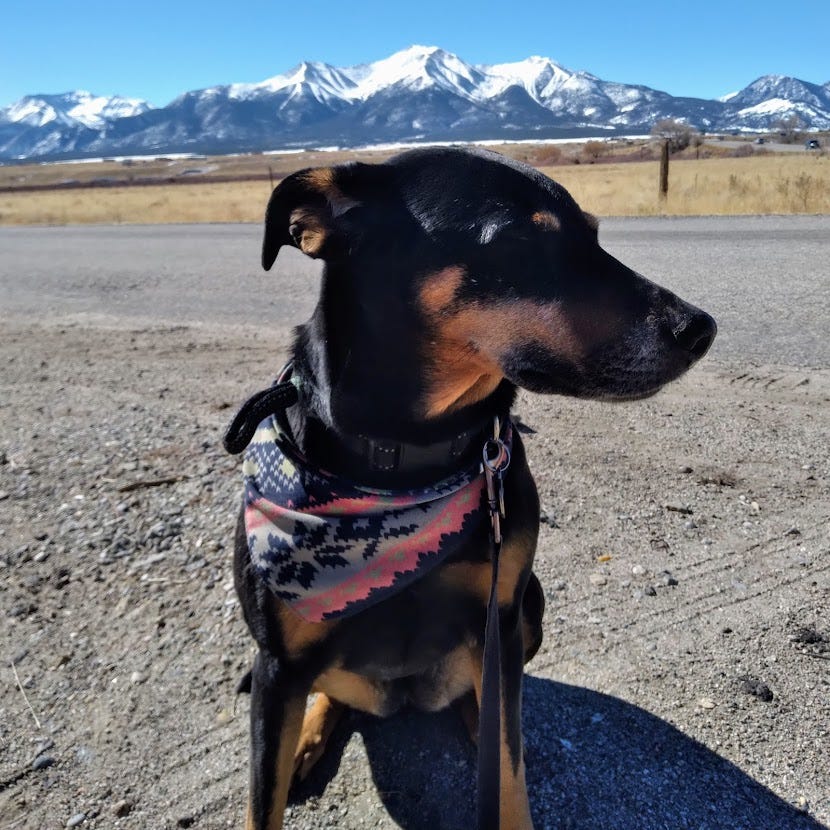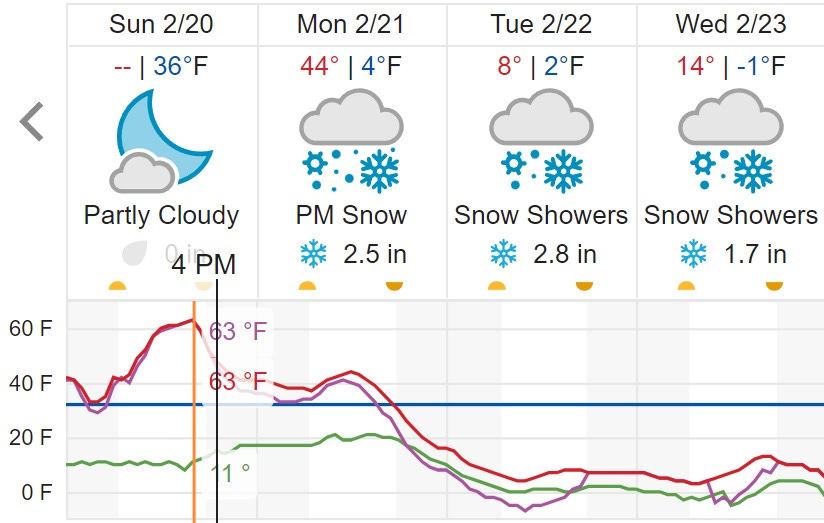Whistling along the Colorado River, Part 3
Wherein a nervous dog decides one of America's most dangerous highways is a proper time for a nap
Reference material:
Sorry to spoil the climactic ending of this miniseries, but Rosie and I made it back to Boulder on Saturday afternoon, and within twenty-four hours were fully re-acclimated to both the peculiar annoyances and the undeniable perks of our humble, low-altitude home base.
Rosie and I didn’t wind up seeing much of Durango on Wednesday night. The light snowfall that had started shortly before we arrived in town continued into the next morning, making for slippery and inhospitable downtown sidewalks. Moreover, I discovered soon after checking in that this hotel doesn’t allow non-service pets; when making the reservation, I had assumed otherwise based on every recent stay in a franchisee of this same ground-floor motel chain. I figured that if we kept quiet and out of sight, we’d be on our way in the morning having committed a harmless violation of hotel policy (as a rewards-club member, no less) and pay no penalty for my lapse.
Our immediate neighbor in the hotel became fast friends with Rosie as one of us sneaked out for a pee break. She promised not to tattle, and allowed that for her part, she would be busy smoking weed. Her car had Missouri plates. A woman in her early thirties, traveling alone a great distance and staying in budget hotels in workout gear. You always wonder, even if you’re never going to—and shouldn’t—ask.
As it happens, Rosie may not have made any noise or done any palpable harm overnight, but her presence didn’t go unnoticed, as on Saturday I noticed an “unexplained” $99 charge on my credit card from the same stay—an amount that would seem to comport with staying with an undeclared pet, or doing small hits from an undeclared bowl and hoping all the smell goes out the window before the maid comes in after you bolt for the next such villa down to the turnpike. (This makes me lazily wish I had done exactly $99 in damage to the room, which is an example of what economists have in mind when they talk about “moral hazard.”)
I decided late the night before leaving Durango that we would head for Alamosa, three hours to the east. I knew we would negotiate at least one high mountain pass, as we’d be crossing the Continental Divide, reputed to be visible from the moon on a cloudless day in both locales. Based on the Google-anticipated 50-MPH average speed and a favorable weather forecast, I guessed that the drive would be no more remarkable than that on any other Colorado mountain road.
I was wrong about that, and far better for my ignorance. U.S. Route 160 in Colorado is among the most dangerous highways in the country, at least for truckers. Specifically, Wolf Creek Pass can be a lethal, if aesthetically nonpareil, place to be in the wintertime.
The steepest grades are found on the western side of the pass, so in theory it was good that we were driving eastward and would enjoy a descent incrementally less taxing on the car’s brakes. But in a MINI Cooper—which roads like these were veritably made for despite pre-dating the vehicle itself by decades—it doesn’t really matter. What I should have been worried about was the higher likelihood of encountering a runaway truck coming the other way when that truck was itself pointed downhill. Especially because, despite generally clear skies, we experienced dustings of snow throughout the trip.
In fact, we didn’t see many trucks. We didn’t see many other cars, though the road was far from deserted. It was easy to handle the sharpest and steepest sections without any sense of danger. And for the second straight day, I genuinely enjoyed a long drive. Rosie must have sensed my unusual serenity, because she clambered into the back seat and curled up for an extended nap on the descent into South Fork, a rarity for her under any circumstances. This reminds me of the babies who cry their heads before a plane starts taxiing for its take-off, then manage to slumber through an ascent featuring jarring levels of turbulence while every sober adult on the plane is white-knuckling it.
My car had developed a potentially serious safety issue even before I got to Durango: Being unable to get windshield-washer fluid from the coolant tank to the windshield. At first, I thought the spray nozzles had become clogged, because I could hear the front and rear pump motors humming when I activated the sprayer controls, ruling out a blown fuse. But now I think a hose has come loose or sprung a leak. In any case, I had decided to confront this problem before leaving Cortez by overfilling the coolant tank, which celebrated by spilling some of the extra onto the engine block during the drive. As I discovered after getting out of the car in Durango, that shit stinks when quickly heated, and it’s a bad idea in any case to inhale ethylene glycol fumes. Luckily, no one was riding under the hood during that mostly sad trip through northwesternmost New Mexico.
This makes it hazardous to follow closely behind vehicles even on completely dry roads, and when too close to another vehicle on wet, dirty roads, it’s easy to become immediately blinded for a few seconds as the windshield-wipers do a cruddy five-second job that they’d ordinarily handle cleanly in a single swipe. But en route to Durango, and for the rest of the trip, the roads were sufficiently dry and clear of other motorists for me to avoid any sudden-blindness-related catastrophes. (Now that I’m in Boulder and don’t really need a clear windshield while driving, I’ll continue not dealing with this deficiency as well as the car’s faulty passenger-window seal, especially given the weather we’re expecting in the days to come.)
We reached Alamosa safely on Thursday afternoon. This is the home of Adams State University, perennially featuring outstanding Division II cross-country teams. In 1982, the Grizzlies achieved a perfect score of 15 points at the NCAA national championships. I happened to choose a Days Inn close to a dirt path on a berm near the Rio Grande River that the varsity runners must regularly use for easy runs, because Rosie and I saw a few of them when we explored this territory on Thursday and Friday afternoon.
I was originally planning to spend only one night in Alamosa, but the sights on Thursday—including a squirrel-riddled park close to the part of the berm trail we accessed—were enough to convince me to linger for one more night. We ordered Domino’s on Friday evening, probably my most shameful behavior of the whole trip, and packed what was left for Saturday’s 225-mile drive north and northeast over another series of high mountain passes. The weather for the drive was fantastic, but Rosie was more unsettled than she had been on the way to Alamosa, at least on the long flat section at the beginning. So, I stopped a few times, which my caffeine-battered bladder and slowly bloating prostate both appreciated, and in Johnson Village got a few photos of the mountains to the west and south.
In the photo below, the highest apparent peak is Mt. Princeton, but the top Mt. Antero, off to the left with the obvious bowl in it, reaches higher (14,276’ vs 14,204’ above sea level). These are the 11th- and 15th-highest of the 26 major peaks in Colorado reaching an elevation of 14,000’ or more, and only two peaks in the continental United States outside the state (Mount Whitney and Mount Rainier) exceed their loftiness.
Those peaks are around 6,400' higher than the spot where I took the photo, already at 7,850' elevation. That's almost as much vertical difference as that between the peak of Mount Mitchell, the highest peak east of the Rockies, and the Atlantic Ocean. The Rockies are very different from the Appalachians—those are just overgrown hills.
In the final stretch of the trip coming through Golden, on a part of Route 93 I rarely drive on, I was reminded that until you reach to the southern border of Boulder County via this route, if you’ve never been here, you would have no sense that a decent-sized city lies anywhere nearby. To the left is a strip of mountains and to the right, nothing but rolling green hills.
We got home early enough in the day to do a short run and a much-needed load of laundry, and on Sunday morning we did a longer one on what passes for our most common route. Rosie seems to like the variety of new runs, new hotel rooms and new things generally, but when she knows she has prairie dog fields ahead of her when she takes the right turns, she unquestionably likes being out there running with me more. Whenever I leave and come back, Boulder without a doubt feels like home, as fraught with imperfections as it may be. That has a lot to do with things that are not necessarily mine alone to decide.
After tomorrow afternoon, I don’t think Rosie will be eager to spend much time outdoors, on our usual routes or anywhere, until the week is well over half over.
A sixty-degree temperature swing in around 36 hours is fairly obscene, but also something that happens several times a year around here.
But even if I wind up sitting indoors for a bit, at least now I can say for the first time that I have seen every general portion or region of the state of Colorado. And it’s a treat to have easy access to all of it.






